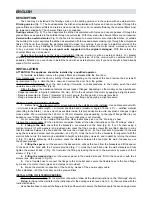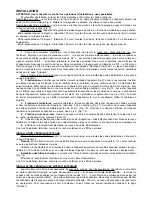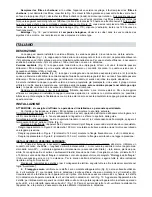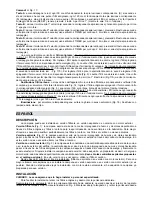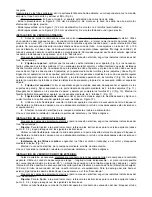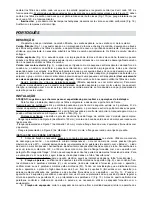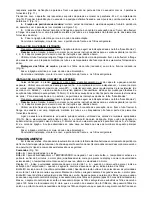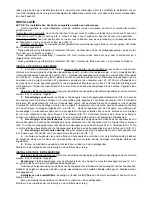
ENGLISH
DESCRIPTION
The hood may be installed in the filtering version, in the ducting version or in the version with an external motor.
Filtering version (Fig. 1): The hood aspirates the kitchen air saturated with fumes and odours, purifies it through the
grease filters and charcoal filters and returns clean air into the room. For constant efficiency, the charcoal filters must
be replaced periodically. The charcoal filters are not supplied.
Ducting version (Fig. 2): The hood aspirates the kitchen air saturated with fumes and odours, passes it through the
grease filters and expels it to the outside through an outlet pipe. With this version the charcoal filters are not required.
Version with an external motor (Fig. 3): the hood is connected to a vacuum motor set outside the kitchen, or outside
the building; the motor aspirates the kitchen air saturated with fumes and odours making it go through the anti-grease
filters of the hood, then through the air disposal duct to make it go outside. If you chose to install this version of the
hood, you have to buy it already fit for this installation, which means without the motor inside; moreover you have
to buy a vacuum motor (only use vacuum units suggested in the original catalogue). With this version the
charcoal filters are not required.
Decide from the outset on the type of installation (filtering, ducting or with an external motor). For greater
efficiency, we recommend you install the hood in the ducting version or in the version with an external motor (if
possible). Attention: you can chose to install the hood with an external motor only if you have bought a hood already
planed for this version.
INSTALLATION
ATTENTION: The appliance should be installed by a qualified operator.
To facilitate installation, remove the grease filters and disassemble the front door.
Door disassembly: open the door by pulling it forwards; operating on the inside of the hood remove the 2 screws D
as illustrated in Fig. 4. Hold the tab L down and remove the door from the guides.
Grease filters disassembly: open the door pulling it forwards; in correspondence to the handle, push the catch
upwards and extract the filter (Fig. 5).
Fitting the flange: the appliance features various types of flanges, depending on the model you have purchased.
- Flange represented in Figure 6 (diameter 150 mm): fit it to the air outlet of the motor by applying a slight pressure.
- Flange represented in Figure 7 (diameter 125 mm): secure the flange with 2 screws (provided).
- Flange represented in Figure 8 (diameter 150 mm): fit the flange by applying a slight pressure.
INSTALLATION IN DUCTING VERSION:
1.
Before fixing, the disposal duct for air evacuation to the outside must be installed. Use an disposal duct with:
– minimum indispensable length; – minimum possible bends (maximum angle of bend: 90°); – certified material
(according to the State); – an as smooth as possible inside. It is also advisable to avoid any drastic changes in pipe
cross-section. We recommend the 125 mm or 150 mm diameter pipe depending on the type of flange fitted to your
appliance (see “Fitting the flange” paragraph). The air outlet pipe is not provided.
For air evacuation to the outside, follow all the other instructions given on the “Warnings” sheet.
Prepare the power supply (for the electrical connection, follow all the other instructions on the “Warnings” sheet).
2.
Fixing to the wall: check that the brackets L are mounted on the hood (Fig. 9); if not, fix them using 2
metrical screws (V) with washers (all provided); also check that the 2 metric screws (M) are fitted. Bearing in mind
that the distance between the hood and the hob must be at least 65 cm, fix the 2 brackets S (provided) to the wall
using the screws and screw anchors provided – see Fig. 10. Hook the hood to the 2 brackets; for alignment with the
wall or kitchen units, the hood may be adjusted in height by turning the screws M, and in depth by turning the screws
V (Fig. 10). Before tightening all the screws, check the distance between the hood and the wall; if necessary, use
the spacer provided.
3.
Fitting the spacer: cut the spacer to the desired size; unhook the hood from the brackets and fit the spacer
to the back of the hood with the 3 screws provided (Fig. 11). Hook the hood back onto the wall brackets and fully
tighten the screws M and V (Fig. 10). Complete the fitting by locking the hood to the wall units by means of the 4
screws C (Fig. 12).
4.
Fitting the wooden door: cut the wooden panel to the desired size and fit it to the hood door with the 4
screws (see dimensions in Fig.13).
5.
Use a flexible hose to connect the flange to the air outlet duct: secure the flexible hose to the hood flange
by means of a metal clamp (pipes and clamps not provided).
6.
Make the electrical connection of the hood by means of the power supply cable.
After installation, refit the front door and the grease filters.
INSTALLATION IN FILTERING VERSION:
Prepare the power supply (for the electrical connection, follow all the other instructions on the “Warnings” sheet).
Fixing: for fixing to the wall refer to the instructions for the ducting version (see point 2, 3, 4), then continue with the
instructions below.
Use a flexible hose to connect the flange to the top of the wall unit: secure the flexible hose to the hood using a metal


